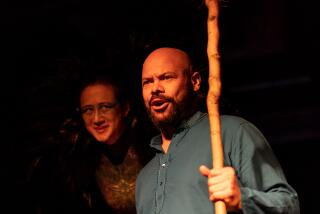Get thee to a libr’ry
- Share via
Bookstores and libraries are stocked with weighty tomes devoted to Shakespeare’s life and works, some exhaustively researched, some just exhausting. It takes a certain amount of resolve -- or masochism -- to spend seven years of your life just to create another volume for the shelf. What more is there to say, after all?
Plenty, it turns out.
“The hardest thing was what to leave out,” said Leslie Dunton-Downer of the “Essential Shakespeare Handbook,” from DK Publishing Inc.
The book’s encyclopedic, 480-page content is comprehensive, but it’s the innovative format that may set it apart.
Dunton-Downer, a Shakespeare scholar and former Harvard lecturer, and co-author Alan Riding, European cultural correspondent for the New York Times, have taken a heightened visual approach that owes as much to Internet culture as to iconographic travel guides and the increasing popularity of graphic novels.
“The visual culture of reading has become so important,” Dunton-Downer said. “It seemed that there was a need for a book that would tap into the richness of Shakespearean visual culture and at the same time convey some of the wonderful things about the plays and the life of Shakespeare.”
The text explores each play and examines the context, past and present, to explain and define Shakespeare’s life and work, from historical roots to modern-day film and stage adaptations.
Pages are color-coded green for history plays, purple for romances, etc. And they’re filled with photographs, illustrations, charts, boxes, bars and icons.
“I was thinking very fondly of the students I’d had when I was teaching,” Dunton-Downer said, “and about people who were afraid of Shakespeare. Alan was thinking of people who attend the plays. We wanted to make a portable volume that could be consulted without making people feel overwhelmed but capture the breadth of the material.”
On his language legacy:
Shakespeare’s lexical creativity was not limited to languages from distant lands or times. From existing English or Germanic origin he formed the adjective “kissing,” the nouns “amazement,” “eyeball” and “scuffle,” the verb “swagger” and another whose straightforwardness still shocks: “puke.”
The perils of theater:
In Shakespeare’s time, amphitheaters like the Globe prompted audiences to recall the precariousness of life. Large and crowded theaters, natural breeding grounds for deadly diseases, were routinely shut during the plague epidemics that swept through London. Gorier tragedies, such as “Titus Andronicus” and “Macbeth,” left the stage of the Globe awash with the sight and smell of blood.
Uses for “Hamlet”:
Two amateur performances aboard the East India Co. ship Dragon were recorded during Shakespeare’s lifetime. On March 31, 1608, Captain Keeling noted: “I invited Captain Hawkins to a fish dinner, and had Hamlet acted aboard me, which I permit to keep my people from idleness and unlawful games or sleep.”
On authorship myths:
Introducing the [“First Folio”], the actors John Hemminge and Henry Condell, as well as the playwright Ben Jonson, speak of Shakespeare with fondness and admiration. Would they really have gone to the trouble of perpetuating the lie that Shakespeare was the author of poetry and plays written by someone else? In the gossipy world of London’s theaters, such a hoax would soon have been exposed.
More to Read
Sign up for our Book Club newsletter
Get the latest news, events and more from the Los Angeles Times Book Club, and help us get L.A. reading and talking.
You may occasionally receive promotional content from the Los Angeles Times.







